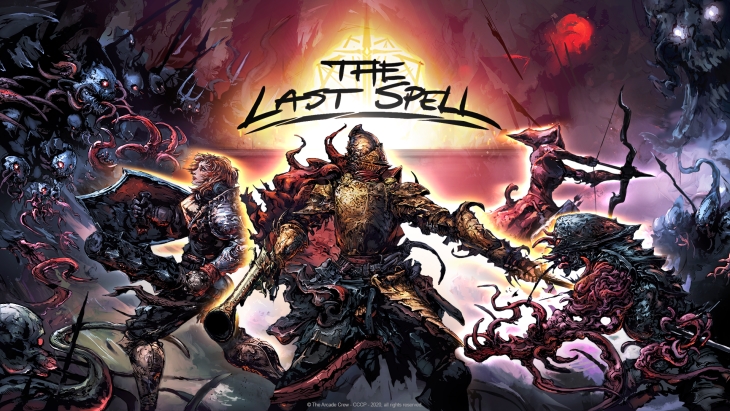
Early access games are rarely a seamless gameplay experience; often plagued by game breaking bugs, crashes, and other satisfaction killing incidents. The pre-Early Access build of The Last Spell surprised me; being a well-designed post-catastrophe fantasy setting.
It immediately conveys the hopeless pursuit of three defenders as they fight to protect the remaining haven of mankind from the unyielding flood of monstrosities; all in hope that there will be enough time for The Last Spell to be cast.
The Last Spell
Developer: Ishtar Games
Publisher: The Arcade Crew, Gamera Game
Platform: Windows PC (Reviewed)
Release Date: June 3rd, 2021 (Early Access)
Players: 1
MSRP: $19.99 USD
This review is coupled with a supplemental video review. You can watch the video review above or read the full review of the game below. This review was of the pre-Early Access version (v0.89.3_beta).
The game establishes its tone with dark and moody pixel art curated for the bleak post-apocalypse world. It combines the role-playing appeal of RPGs like Chrono Trigger, and the POV of strategy-based games like Age of Empires. Populating the field of battle with retro sprites and giving the player a true isometric point of view.
The map, cramped full of unrepairable dilapidated buildings and surrounded by ever-pressing mist, gives no sense of comfort or safety. The visuals and sound successfully express the hopelessness and desperation of the Heroes plight as each night fell.
I am happy to say the gameplay did not lack either. The uncompromising survival-tactics, roguelite elements, and RPG traits combine into a delicious and rewarding gumbo for each attempt. Gameplay variety is a large focus, with a diversity of methods available for approaching the foes.
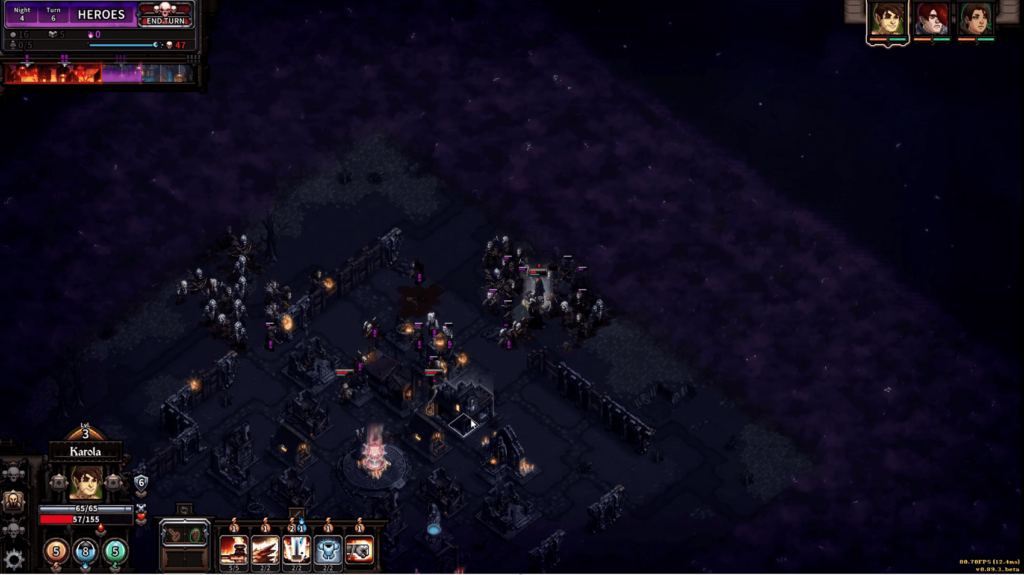
The survival-tactics manifest most strongly in the first several hours of gameplay. The randomly generated set of three Heroes start by defending a half-destroyed Haven. In the beginning they are at their weakest; with low starting action points, unfavorable odds for skills and weapons, and the lowest starting defenses.
It quickly becomes apparent that every single move in the turn based fights determines the success of the run. There is no room for error as Crawlers swarm the ill-defended town, devoid of even walls. The goal? To defend the heart of the town. The challenge? 12 increasingly hardier floods of Crawlers, no punches pulled and scant health and mana regenerated for the following night.
This makes managing health and mana two of the most critical resources in the game. The characters quickly become wearied, low on health and depleted in the mana necessary for their skills. Mediocre resource management is not enough to preserve them and fortify the town with additional critical infrastructure. It doesn’t help that the initial Hero starting characteristics are frequently debuffs.
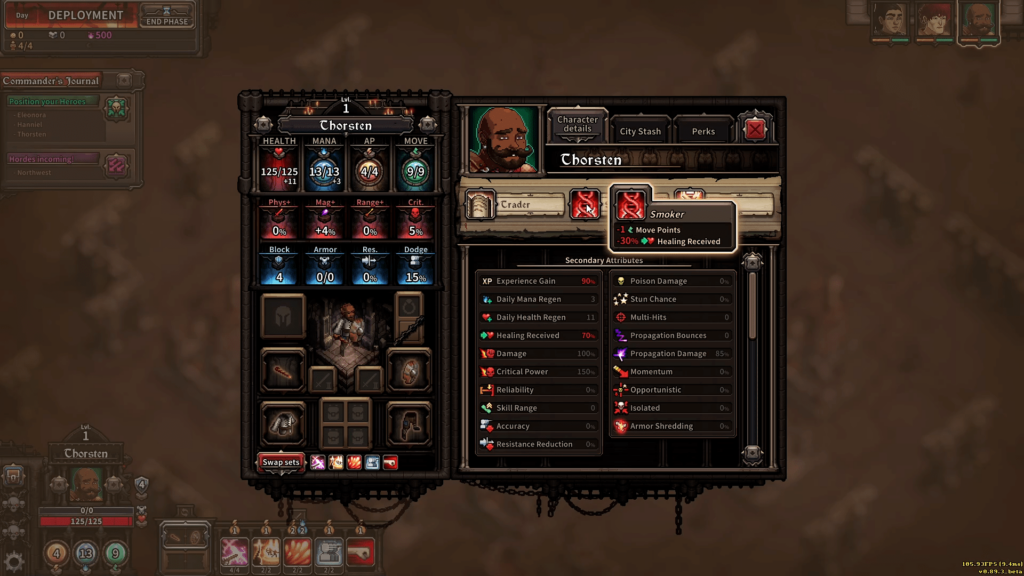
The combat is best described as a tower defense game with tactical-turn based mechanics. Sprinkle in a little RPG traits in leveling up the Heroes and make it a roguelite by scraping most progress between runs and we’ve essentially captured the core of the game.
The Heroes start with randomized primary and secondary attributes, a few characteristics that buff or debuff them, and their equipment. There are no classes in this game, and only the strategic use of experience will build up to useful roles.
The most decisive element is the Heroes weapon; each pre-set with specific skills and have no requisites for equipping. These skills require a variety of action points, movement, and/or mana to use during battle.
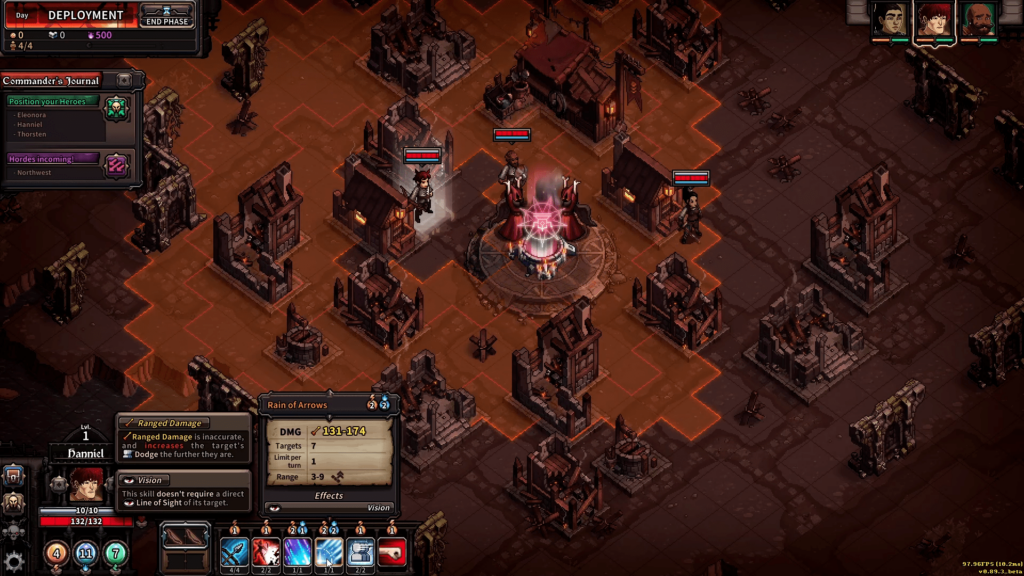
Other equipment can add on to the buffs on any Hero, some even very helpful buffs. Heroes can have two weapons on their person, and switch them between freely. This gives about 4 to 10 skills per Hero for each turn.
Experimenting with different weaponry and skill sets is huge for learning to strategically dealing with the hordes. Each start of new heroes could potentially be curated into the player’s ideal combination of melee, range, and magic yielders.
The hordes are no joke either – with each night introducing new varieties of the Crawlers. Each night is a challenge to prioritizing fast runners, wear down the heavily armored, and take down the bulk knocking on the walls.
The above is only representative of the first few nights, where each success brings new challenges in the Crawlers. The combination of sheer numbers and varied attacks require careful planning for each player turn – and quickly becomes overwhelming.
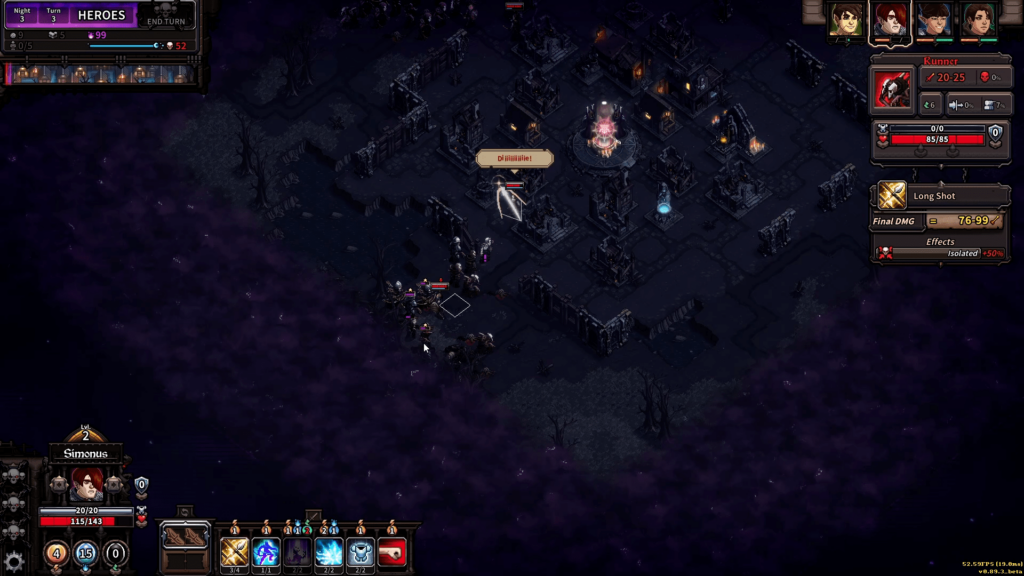
At the end of a successful night you build the town and manage resources in the Production phase. In some other roguelites there may be a period of recuperation after each failed attempt. Here, as the initial base is randomly generated, each battle ends in a period of improvement.
However, there are meager awards for surviving the night- with scant amounts of experience, gold, materials, and tainted essences allotted. Calculated use of these four components are core to improving the characters and easing the game.
Experience is determined by a character’s starting attributes. Some start with subpar EXP gain rates, lower health, and other unfavorable stats. However, the attributes can be improved when level ups are awarded.
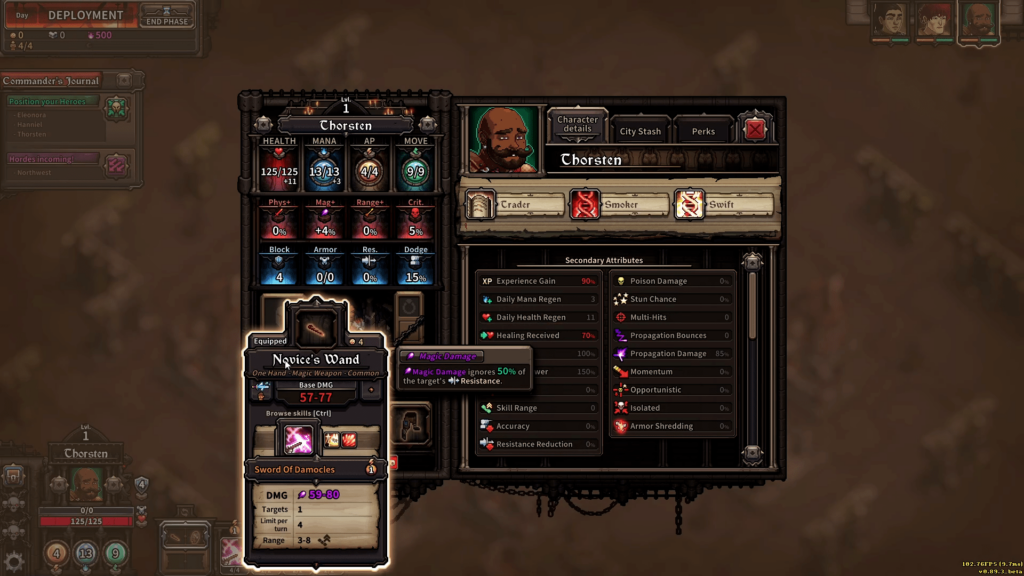
There is some ambiguity as to how the level ups affect certain skills, my overall biggest criticism, but the system sorts itself out you experiment with it.
Having some previous experience in RPGs definitely helps here. Gold and materials are awarded based on how much of the town survived the night.
More structures destroyed means less reward, making it more punishing when the player falls behind. Gold is used to purchase buildings such as armories and mines.
Materials build fortifications such as walls and gates. Gold can also be used to supply more materials during the production phase, albeit indirectly and after unlocking additional structures
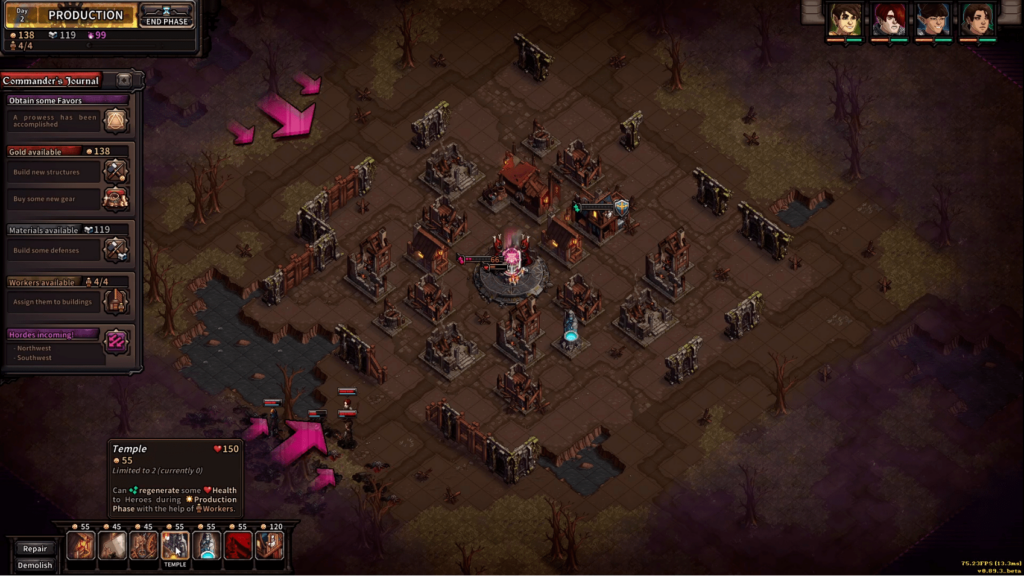
The Tainted Essences are gathered by killing Crawlers, but affected by modifiers on the character who makes the kill. Essences unlock more general improvements for the base of each run, along with unlocking more weapon sets and improving base character attributes.
After surviving the night and spending limited resources there is technically a third phase, Deployment. This gives a space for the player to strategically place Heroes before the night begins. In practice however, this phase felt redundant.
It’s reasonable to suggest it was included to ensure players didn’t skip from Production to night. This would easily be a game-ending mistake as positioning is paramount. The Deployment phase would make more sense if you were unable to move your Heroes during the Production phase. As it is, I clicked straight through, having already prepared my Heroes for the night in the previous phase.
Other than the harsh survival conditions, requisite tactical approach, and roguelite elements; the RPG characteristics are unique to each run. Leveling up the crew allows for formulating specific combinations of weapons and skill sets that suit a personal playstyle and strategy.
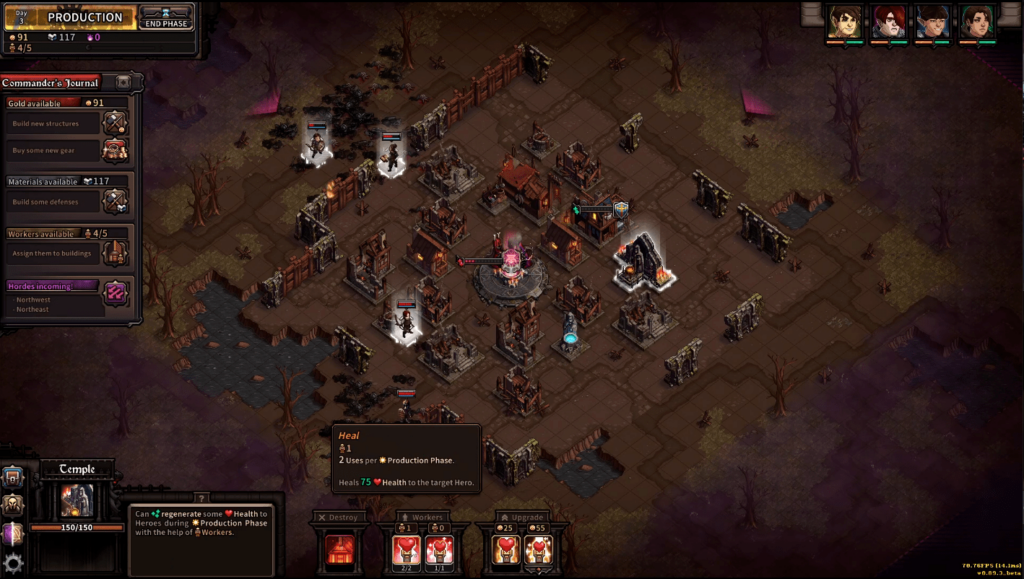
Each Hero accumulates EXP from surviving the night. The EXP directly levels up their individual attributes and attributes of their weapon skill sets. However, instead of a flat character sheet to upgrade as you will, each level up has randomly generated choices to make. Heroes have five randomly generated boosts to pick from, with a mixture of standard, rare, and epic upgrades possible.
These options are what EXP directly translates to. For each level the character gets a primary and secondary attribute upgrade, and one Perk. The Perks are consistent and help to reliably boost specific skill sets, when the randomly generated attributes weren’t falling in my favor. Once a run is lost, so are the Heroes and all experience awarded removed; except for upgrades purchased with Tainted Essences.
At the end of each night we visit the Oraculum, home to two figures who are slowly revealed over gameplay. When trading Tainted Essence, you receive quality of life upgrades from the mysterious dark shadowed figure. These typically are better item sets and improved starting stats of the base Heroes.
Alternatively, the Oraculum’s light side gives perks based on player experience. “Survive night 6, unlock Seer building with ability to foresee glimpses of enemy horde and repel mist” for example.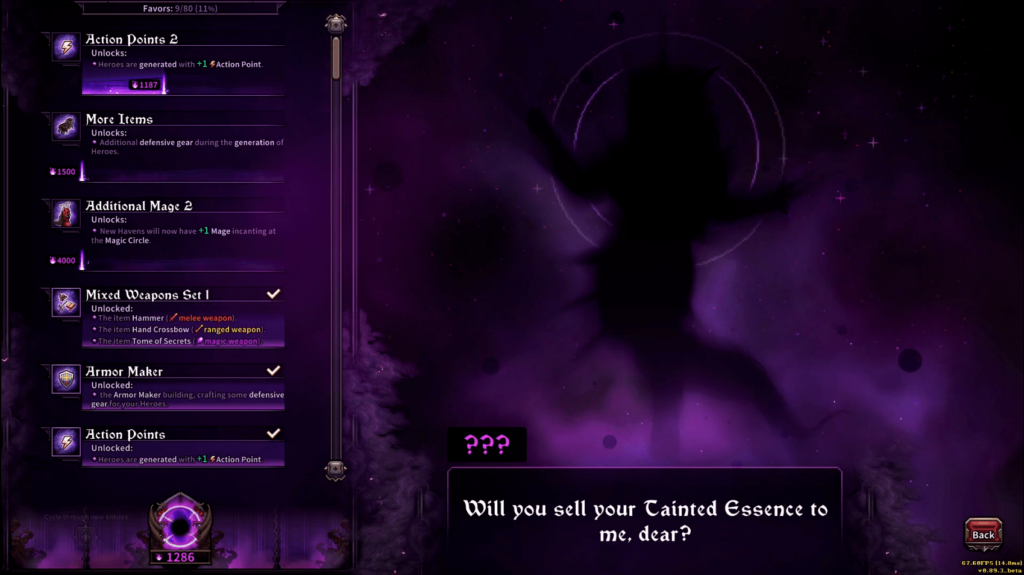
Both slowly ease the difficulty of the game by unlocking stronger bases, and more favorable Heroes. The Oraculum can be accessed during any Production phase, or at the end of a run before starting a new attempt. The upgrades unlocked mid-run are typically immediately available in the pool of random item generation.
Random chance and overarching improvements to each run felt like a balanced take between complete randomization, and enough control for a viable chance of make it to the end of a turn. I would say this was one of the more successful elements of the game.
The inevitable perks unlocked through gameplay combined with the natural learning curve matched the increasing difficulty of the progressive nights. I never felt that I lost unfairly, nor did I survive from sheer luck. The harmony they achieved between challenging gameplay mechanics in the face of growing opposition and continued rewards craftily won me over. On top of the satisfying gameplay, the music formed the perfect complement. My first impression of the dramatic intro, with the slow synth quickly ramping into the full metal encore of riveting, blood seeking excitement.
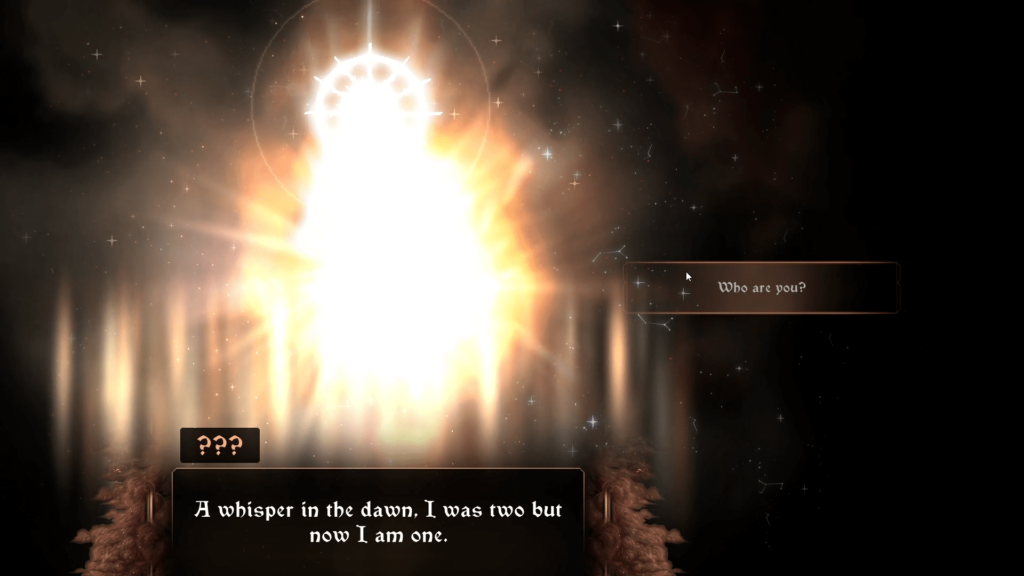
It had me immediately pumped to knock some Crawler hordes to the ground. Each phase has its unique tone, and I would love to have the soundtrack if it’s released.
The story was where the game originally fell apart for me. The pre-Early Access version left me disappointed by the confusing dialogue and absent story. However, the official Early Access copy does include a prologue that helped clear up a few points.
I had optimism that the Early Access version would improve on the story after more development and Ishtar Games didn’t disappoint. The prologue neatly captures the pursuit of the game and serves as a motivating piece that I want to see more of.
The only caveat is that the dialogue options in the Oraculum, where the story continues to progress, are lacking in options and writing. However, given my pre-Early Access version has already been improved for the main story, I am curious to see if they have continued to flesh out the Oraculum interactions as well and will find out as I play more.
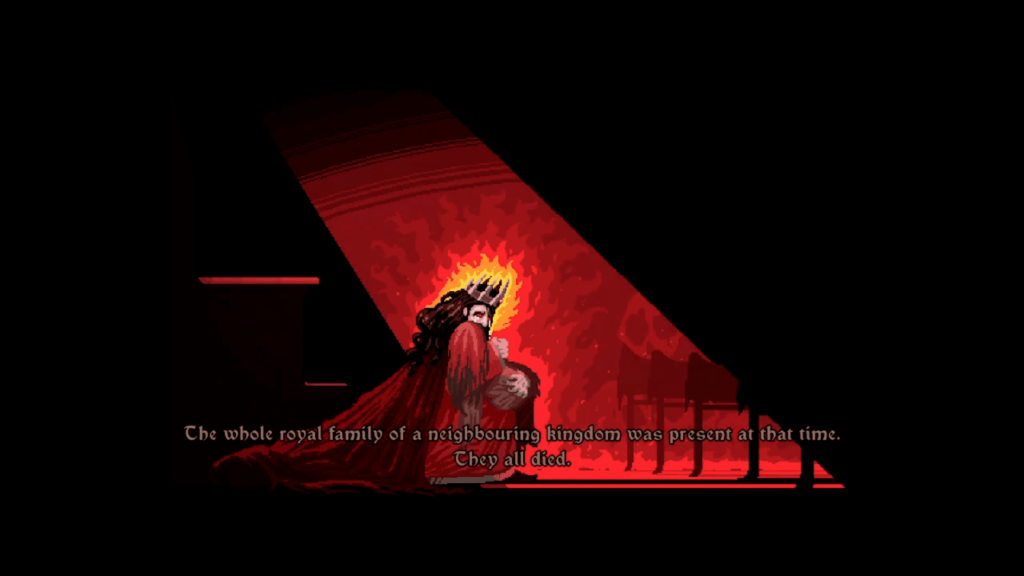
Ultimately, The Last Spell is freaking good, even in its infancy. Even if you aren’t into brutally challenging games; it’s rewarding in its engaging soundtrack, satisfying game mechanics, and its immersive, desperate, and futile world where most adventures will inevitably lead to brutal and bloody failure.
The Last Spell was previewed on Windows PC using a review code provided by The Arcade Crew and Gamera Game. You can find additional information about Niche Gamer’s review/ethics policy here.